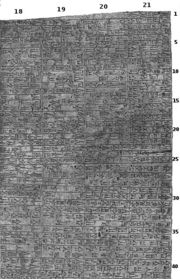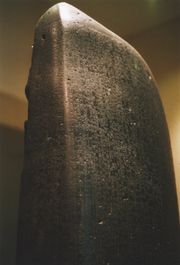Code of Hammurabi
2007 Schools Wikipedia Selection. Related subjects: Ancient History, Classical History and Mythology
The Code of Hammurabi (also known as the Codex Hammurabi and Hammurabi's Code), created ca. 1780 BC ( short chronology), is one of the earliest extant sets of laws and one of the best preserved examples of this type of document from ancient Mesopotamia. Still earlier collections of laws include the codex of Ur-Nammu, king of Ur (ca. 2050 BC), the Codex of Eshnunna (ca. 1930 BC) and the codex of Lipit-Ishtar of Isin (ca. 1870 BC).
It shows rules and punishments if those rules are broken, the punishments could be as little as a fine or as big as sentencing to death. It focuses on theft, agriculture (or shepherding), property damage, women's rights, marriage rights, children's rights, slave rights, murder, death, and injury. The punishment varies depending on the class of offenders and victims. For a comprehensive summary, see Babylonian law.
The laws do not accept excuses or explanations for mistakes or fault: the Code was openly displayed for all to see, so no man could plead ignorance of the law as an excuse. Few people, however, could read in that era (literacy mainly being the domain of scribes).
Hammurabi (1728 BC–1686 BC) felt he had to write the code to please his gods. Unlike many earlier and contemporary kings, he did not consider himself related to any god, although he did call himself "the favorite of the gods." In the upper part of the stela, Hammurabi is shown in front of the throne of the sun god Shamash.
The laws (numbered from 1 to 282, but numbers 13 and 66-99 are missing) are inscribed in Old Babylonian on an eight foot tall stela of black basalt . It was discovered in December 1901 in Susa, Elam, which is now Khuzestan, Iran, where it had been taken as plunder by the Elamite king Shutruk-Nahhunte in the 12th century BC. It is currently on display at the Louvre Museum in Paris, France.
The code is often pointed to as the first example of the legal concept that some laws are so basic as to be beyond the ability of even a king to change. By writing the laws on stone they were immutable. This concept lives on in most modern legal systems and has given rise to the term written in stone.
The Code of Hammurabi was one of many sets of laws in the Ancient Near East. Most of these law codes, coming from similar cultures and racial groups in a relatively small geographical area, necessarily have passages that resemble each other. For example, the laws found in the later Hittite code of laws (ca. 1300 BC) have some individual laws that bear a passing resemblance to those in the Code of Hammurabi, as well as other codices from the same geographic area. The earlier Ur-Nammu, of the written literature prolific Ur-III dynasty (21st century BC), also produced a code of laws, some of which bear resemblance to certain specific laws in the Code of Hammurabi. The later Mosaic Law (according to the modern documentary hypothesis ca. 700-500 BC - under Hezekiah/ Josiah; traditionally ca. 1200 BC - under Moses) also has some laws that resemble the Code of Hammurabi, as well as other law codes of the region.
Examples
There were 248 laws, which were quite strict. Some of these were:
- If one accuses another with a capital offence, but cannot prove the charges, the accuser will be killed.
- If one accuses another, and can prove it, he shall be rewarded with money.
- If a judge decides in a case, and later it turns out that he was wrong, he will have to pay twelve times as much as he set for the accused, and will never be allowed to judge anymore.
- If one steals the son of another, he will be killed, and buried at the breach.
- If one finds a slave who has run away, and he brings the slave back to his owner, the owner will pay two shekels.
- If a robber is caught while stealing, he will be killed.
- If one does not take good enough care of a dam, and the dam breaks, he shall be sold for money, which will replace the corn ruined due to the over-flooding of the crops.
- If one over-floods a neighbour’s crops, then he shall pay the loss.
- If one gives his garden to a gardener to take care of, and the gardener has done his job well for four years, on the fifth year the owner will have to take part in the gardening.
- If the gardener did not do his job well, and the plants go bad, he shall pay the loss of the bad years according to the neighbour's plant product.
- If one is in debt, and cannot pay, he can sell himself, his wife, his son and his daughter to work; after three years they shall be set free.
- If the one in debt sells a slave to pay his debt, and the slave is good enough, there can be no objection.
- If one marries a woman, but has no relationship with her, it is not considered as a marriage.
- If a wife has a relationship with another man, both shall be tied and thrown into water, but the wife can be pardoned by her husband given to the king as a slave.
- If a man uses violence on another man’s wife to sleep with her, the man shall be killed, but the wife shall be blameless.
- If a man is captured in war, and the wife leaves the house, even though there is enough food, she shall be thrown into water.
- If a man is captured in war, and there is no food, the wife is blameless if she goes to another house.
- If a husband runs away from home, the wife goes to another house, and the husband subsequently returns, the wife does not have to go back.
- If a man wants to separate from a woman who has given birth to his children, a part of land and money has to be given to her by the husband. When the children grow up, the wife can remarry.
- If a man wants to separate from a woman, with no children, he shall have to give back her dowry and the money she has brought from her father’s house.
- If a man adopts a son and he grows up in the adopter’s house, the original parents cannot demand his return.
- If anyone strikes a man whose rank is higher than his, the man shall be whipped sixty times with an ox-whip in public.
- If someone strikes another man equally ranked, he shall pay one gold mina.
- If a slave strikes its owner, his ear will be cut off.
- If a man strikes a pregnant woman, and she therefore loses her child, he shall pay ten shekels for her.
- If anyone strikes anyone of lower rank, the victim shall commit the same injury as was done to him- or herself upon the offender.
- If a builder builds a house, and constructs it well, the owner will pay two shekels for each surface of the house.
- If, however, he does not succeed, and the house falls in, killing the owner, the builder will be killed.
- If the son of the owner dies, the son of the builder shall be killed.
- If a man breaks down a wall of a house in an attempt to rob it (quite literally "breaking into") and is caught, his punishment will be to become sealed up inside the wall as a patch.
- If a son strikes his mother his hands shall be cut off.
- If a son says that his mother is not his mother or his father is not his father his tongue shall be cut off.
- If a man strikes another man, his hand shall be cut off.
- If a man is committed robbery, but can not prove it, his hand shall be cut off.


